Milk Powder Market Size
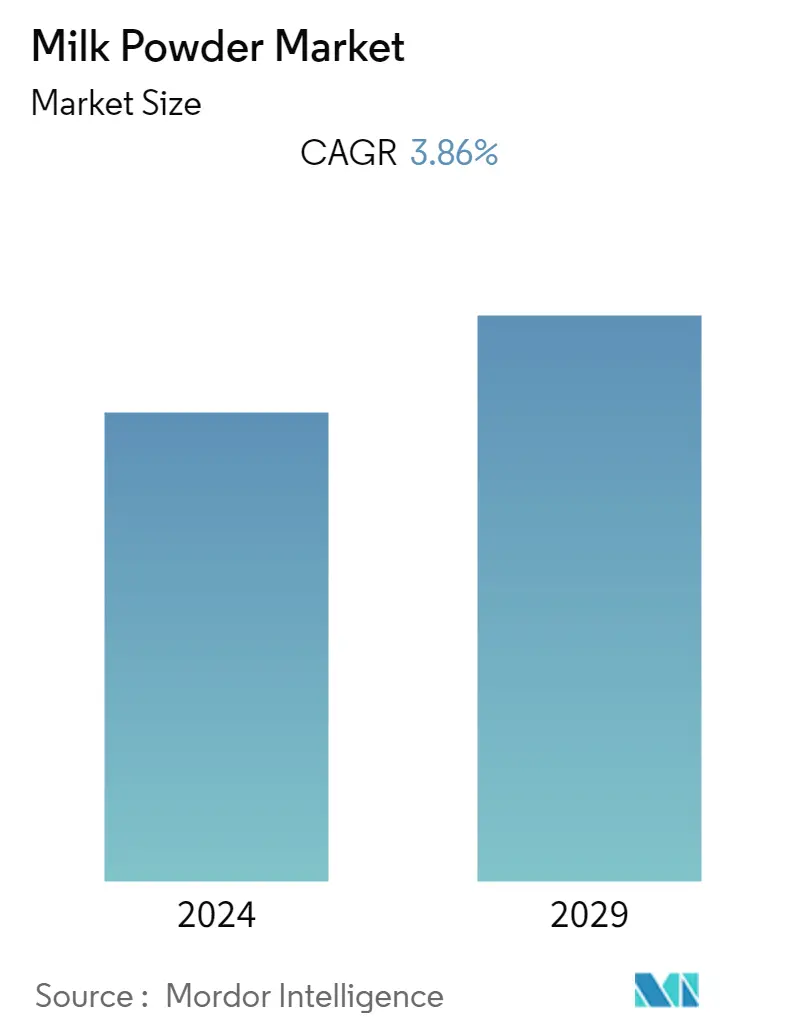
| Study Period | 2019 - 2029 |
| Base Year For Estimation | 2023 |
| CAGR | 3.86 % |
| Fastest Growing Market | Asia Pacific |
| Largest Market | Europe |
| Market Concentration | Low |
Major Players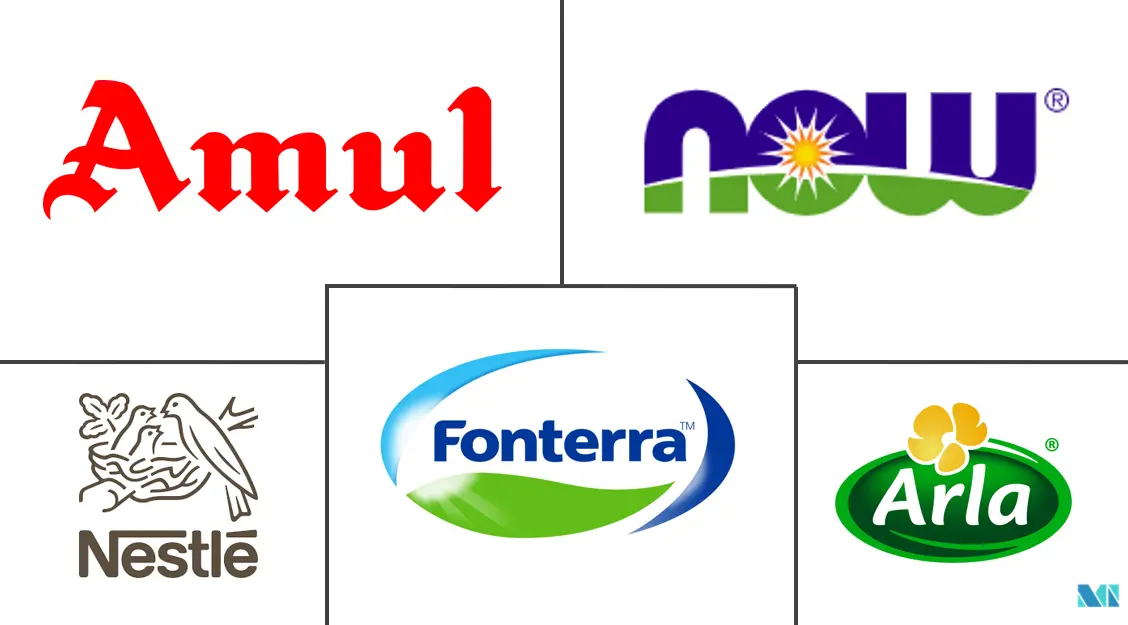
*Disclaimer: Major Players sorted in no particular order |
Milk Powder Market Analysis
The Global Milk Powder Market is projected to record a CAGR of 3.86% over the next five years.
Milk powder is consumed globally, owing to several nutrients, such as vitamin B12, thiamin, and high amounts of protein, driving the global milk powder market. Moreover, milk powder's shelf life is higher than regular milk, leading to increased demand for milk powder over regular milk. Furthermore, skim milk powder is a natural and rich source of proteins. It is also a good source of calcium and is rich in other essential minerals such as selenium, phosphorous, magnesium, potassium, and zinc. It is also low in cholesterol and aids in weight loss, making it ideal for usage by customers suffering from heart disease and obesity. Thus, the global skim milk powder market is expected to project growth.
Consumption of whole milk powder and skimmed milk powder increased as the number of middle-class customers, household incomes, and health consciousness among consumers increased, driving the market growth. Additionally, as of 2022, according to a Maxum Foods analysis, the conflict in Ukraine, the extreme weather, and the rising living cost for consumers continue to impact dairy commodities. The prices of dairy products are anticipated to remain high in the European Union. However, the war caused panic buying and stockpiling various grocery items, especially those with increased shelf life, like milk powder. Supply-side restrictions are anticipated to exist in the upcoming months due to the war in Ukraine keeping the price of dairy products, corn, grain, and fertilizer relatively high.
Milk Powder Market Trends
This section covers the major market trends shaping the Milk Powder Market according to our research experts:
Increasing Health Concern Catalyzing the Milk Powder Market
The development of advanced technologies in milk powders, which helps to retain the nutrient milk content even after the drying process, and very trace amounts of fat, which, in turn, makes it low in calorie content, is driving the attention of the people toward the consumption of milk powder. It helps people to lose or maintain weight and also aids in promoting a healthy heart. Furthermore, as a rich source of complete proteins, which helps build and maintain lean muscles, its consumption also increased among athletes.
Due to the increased milk powder demand, countries across the globe have been importing milk powder to meet the need of the same. In 2021, China's milk production increased by an average rate of 4% due to improved productivity, according to the US Department of Agriculture. The import of milk powder in the country is driven by consumer demand. Most of China's dairy needs are met by imports because the government needs to produce more dairy products on its own and because productivity decreased recently. According to the Department of animal husbandry and dairying, they exported about 17,000 metric tons of milk powder from India in the fiscal year 2021. Compared to the prior fiscal year, there was a rise. The estimated milk powder volume exported during the fiscal year 2022 was 37 thousand MT by the year's end.
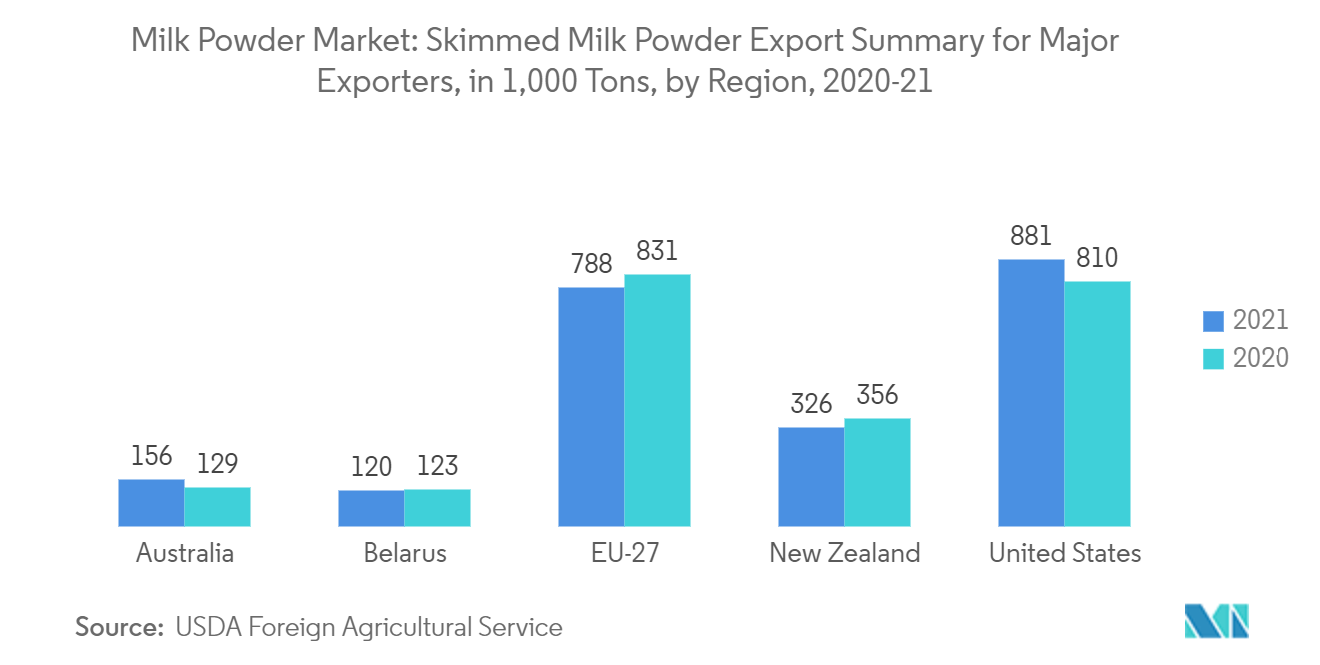
Asia-Pacific is the Leading Market
With the changing lifestyle in the region, Asia-Pacific now dominates the milk powder market. Furthermore, during the projection period, globalization and an increase in the working population will all contribute to the growth of the region's milk powder market. Because of processing and shipping technology advancements, Asia-Pacific is expected to see significant expansion in the milk powder industry. Furthermore, lower transportation costs and the utilization of export subsidies are expected to move the milk powder industry in the region forward. According to the Department of Agriculture, Fisheries, and Forestry, Australian Government, the dairy industry is the most important rural industry. Australia exports nearly 35% of its milk production, and a large proportion of it consists of value-added products like milk powders, ultra-heat treated milk, and other such products.
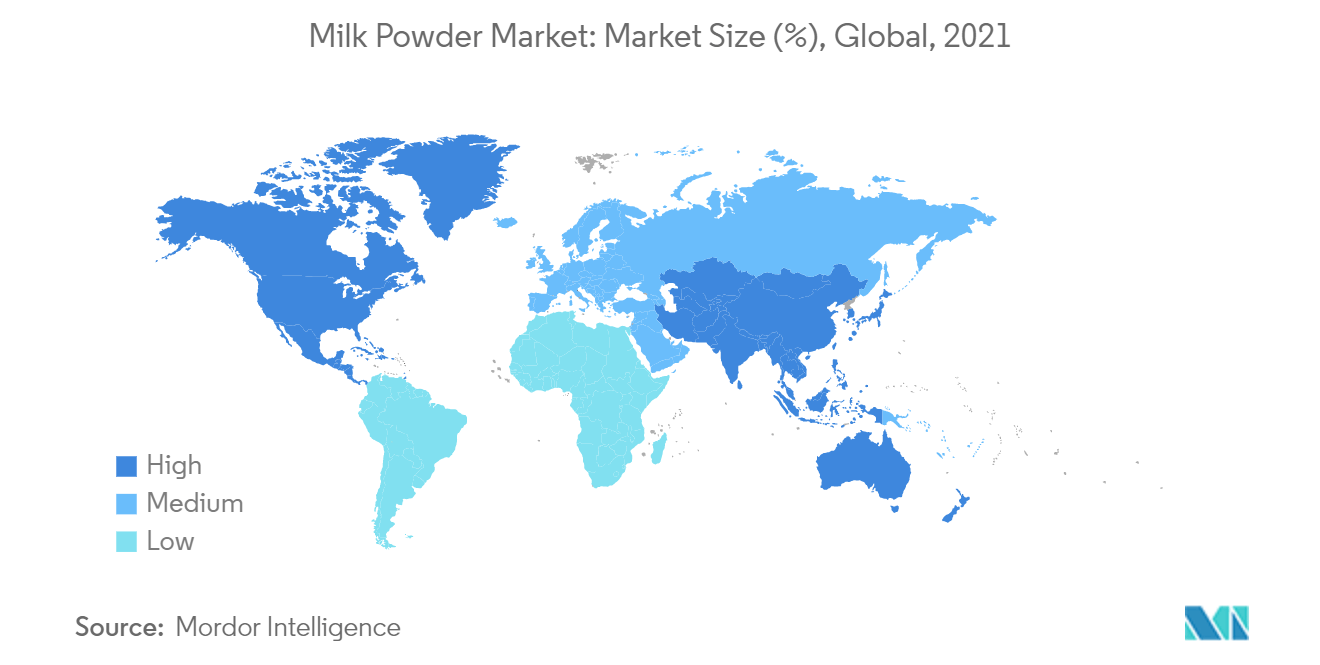
Milk Powder Industry Overview
The global milk powder is fragmented, with many domestic and multinational players competing for market share. Companies focus on new product launches with natural or organic claims as their key marketing strategy. The players focus on unique selling propositions to increase their product sales. The companies are also introducing fortified milk powders that provide extra nutrients to consumers. The market players are also investing in expanding milk powder production and economies of scale and increasing their profits. Significant players include AMUL Fed, Nestlé S.A, Arla Foods, Fonterra Co-Operative Group, and NOW Foods, among others.
Milk Powder Market Leaders
-
Nestle SA
-
Gujarat Cooperative Milk Marketing Federation (Amul)
-
Arla Foods amba
-
Fronterra Co-operative Group
-
NOW Foods
*Disclaimer: Major Players sorted in no particular order
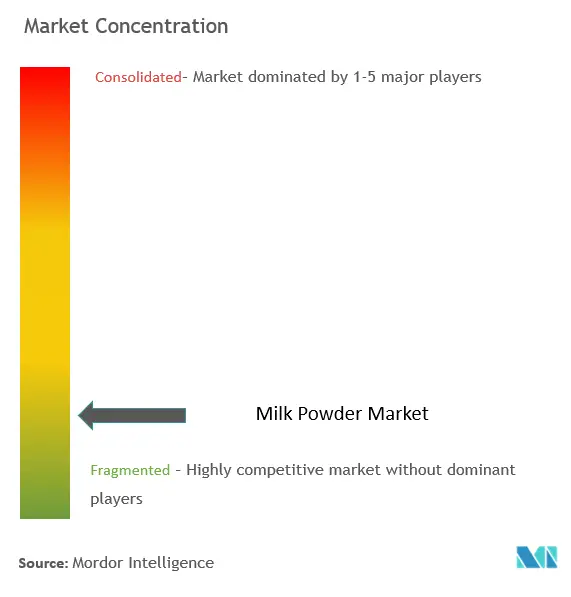
Milk Powder Market News
- December 2022: To revitalize the long-established category, Chinese dairy company Junlebao introduced a new milk powder range- "Le Gai," that supports calcium absorption in middle-aged and elderly consumers. Le Gai milk contains 1200 mg of calcium per 100 g of milk powder, purported to have twice as much calcium as regular whole milk powder as the company claims.
- March 2022: Z Natural Foods announced the release of its new organic oat milk powder. Oat milk powder is available in a 1 lb bag, 5 lb bag, and 50 lb bag. It comes in an air-locked, freezer-tight, resealable, stand-up foil pouch and can be safely stored for two years.
- November 2021: Amul invested INR 415 crore (USD 55.7 Million) in four new projects, including AmulFed Dairy's new milk powder factory. The new milk powder factory's capacity at AmulFed Dairy, a Gujarat Cooperative Milk Marketing Federation (GCMMF) unit, has increased from 35 lakh l per day to 50 lakh l.
Milk Powder Market Report - Table of Contents
1. INTRODUCTION
- 1.1 Study Assumptions and Market Definition
- 1.2 Scope of Study
2. RESEARCH METHODOLOGY
3. EXECUTIVE SUMMARY
4. MARKET DYNAMICS
- 4.1 Market Drivers
- 4.2 Market Restraints
-
4.3 Porter's Five Forces Analysis
- 4.3.1 Bargaining Power of Suppliers
- 4.3.2 Bargaining Power of Buyers/Consumers
- 4.3.3 Threat of New Entrants
- 4.3.4 Threat of Substitute Products
- 4.3.5 Intensity of Competitive Rivalry
5. MARKET SEGMENTATION
-
5.1 Type
- 5.1.1 Dairy Milk Powder
- 5.1.2 Non-Dairy Milk Powder
-
5.2 Distribution Channel
- 5.2.1 Supermarkets/Hypermarkets
- 5.2.2 Convenience Stores
- 5.2.3 Online Retail Stores
- 5.2.4 Other Distribution Channels
-
5.3 Geography
- 5.3.1 North America
- 5.3.1.1 United States
- 5.3.1.2 Canada
- 5.3.1.3 Mexico
- 5.3.1.4 Rest of North America
- 5.3.2 Europe
- 5.3.2.1 Spain
- 5.3.2.2 United Kingdom
- 5.3.2.3 Germany
- 5.3.2.4 France
- 5.3.2.5 Italy
- 5.3.2.6 Russia
- 5.3.2.7 Rest of Europe
- 5.3.3 Asia-Pacific
- 5.3.3.1 China
- 5.3.3.2 Japan
- 5.3.3.3 India
- 5.3.3.4 Australia
- 5.3.3.5 Rest of Asia-Pacific
- 5.3.4 South America
- 5.3.4.1 Brazil
- 5.3.4.2 Argentina
- 5.3.4.3 Rest of South America
- 5.3.5 Middle-East and Africa
- 5.3.5.1 South Africa
- 5.3.5.2 United Arab Emirates
- 5.3.5.3 Rest of Middle-East and Africa
6. COMPETITIVE LANDSCAPE
- 6.1 Most Adopted Strategies
- 6.2 Market Share Analysis
-
6.3 Company Profiles
- 6.3.1 Nestle SA
- 6.3.2 Fonterra Co-operative Group
- 6.3.3 NOW Foods
- 6.3.4 Arla Foods amba
- 6.3.5 Dana Dairy Group
- 6.3.6 Essona Organics
- 6.3.7 Danone SA
- 6.3.8 Gujarat Cooperative Milk Marketing Federation (Amul)
- 6.3.9 Groupe Lactalis
- 6.3.10 Saputo Inc.
- *List Not Exhaustive
7. MARKET OPPORTUNITIES AND FUTURE TRENDS
** Subject To AvailablityMilk Powder Industry Segmentation
Milk powder is a dried dairy product that is prepared by evaporating milk. One reason for drying milk is to preserve it. Milk powder includes a much longer shelf life than liquid milk and, due to its low moisture content, does not need to be refrigerated. The market studied is segmented by type, distribution channel, and geography. The market studied is segmented into dairy and non-dairy milk powder by type. The distribution channel segments the milk market into hypermarkets/supermarkets, convenience stores, online retail stores, and other distribution channels. By geography, the market is segmented into North America, Europe, Asia-Pacific, South America, the Middle East, and Africa. For each segment, the market sizing and forecasts have been done based on value (in USD million).
| Type | Dairy Milk Powder | |
| Non-Dairy Milk Powder | ||
| Distribution Channel | Supermarkets/Hypermarkets | |
| Convenience Stores | ||
| Online Retail Stores | ||
| Other Distribution Channels | ||
| Geography | North America | United States |
| Canada | ||
| Mexico | ||
| Rest of North America | ||
| Geography | Europe | Spain |
| United Kingdom | ||
| Germany | ||
| France | ||
| Italy | ||
| Russia | ||
| Rest of Europe | ||
| Geography | Asia-Pacific | China |
| Japan | ||
| India | ||
| Australia | ||
| Rest of Asia-Pacific | ||
| Geography | South America | Brazil |
| Argentina | ||
| Rest of South America | ||
| Geography | Middle-East and Africa | South Africa |
| United Arab Emirates | ||
| Rest of Middle-East and Africa |
Milk Powder Market Research FAQs
What is the current Milk Powder Market size?
The Milk Powder Market is projected to register a CAGR of 3.86% during the forecast period (2024-2029)
Who are the key players in Milk Powder Market?
Nestle SA, Gujarat Cooperative Milk Marketing Federation (Amul), Arla Foods amba, Fronterra Co-operative Group and NOW Foods are the major companies operating in the Milk Powder Market.
Which is the fastest growing region in Milk Powder Market?
Asia Pacific is estimated to grow at the highest CAGR over the forecast period (2024-2029).
Which region has the biggest share in Milk Powder Market?
In 2024, the Europe accounts for the largest market share in Milk Powder Market.
What years does this Milk Powder Market cover?
The report covers the Milk Powder Market historical market size for years: 2019, 2020, 2021, 2022 and 2023. The report also forecasts the Milk Powder Market size for years: 2024, 2025, 2026, 2027, 2028 and 2029.
What are the key sustainability initiatives being undertaken by Milk Powder manufacturers?
The key sustainability initiatives being undertaken by Milk Powder manufacturers are a) Focus on reduced water usage in production b) Eco-friendly packaging materials c) Minimizing environmental impact throughout the supply chain
Milk Powder Industry Report
The global milk powder market is on an upward trajectory, fueled by its longer shelf life than liquid milk and the increasing consumer demand for durable dairy products. With a growing middle class and heightened health awareness, consumers are gravitating toward whole and skim milk powders, driving market growth. This trend is bolstered by a shift towards nutritionally beneficial and sustainable eating habits, positioning milk powder as an essential component in a variety of culinary settings. While regulatory challenges and the high cost of premium products pose obstacles, the industry is ripe with opportunities, particularly in the plant-based and organic segments, appealing to consumers' preference for on-the-go and health-centric products. Technological advancements and a focus on sustainability are expected to propel market expansion further, meeting the diverse needs of consumers worldwide. Insights from Mordor Intelligence™ forecast a promising outlook for the milk powder market, highlighting its potential for continued growth. Get a sample of this industry analysis as a free report PDF download.



